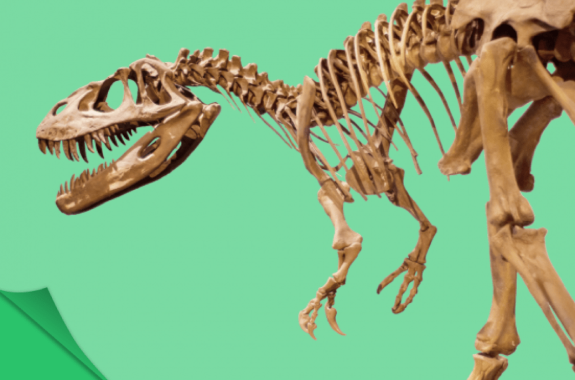What can birds tell us about what dinosaurs looked like and how they moved?
Did you know that not all dinosaurs are extinct? Technically speaking, birds you see today are dinosaurs. How awesome is that?! Look at the skeletons of a Tyrannosaurus rex and a chicken below. The two skeletons are not to scale, they are depicted in these sizes to facilitate observation. What similarities do you see? What differences?
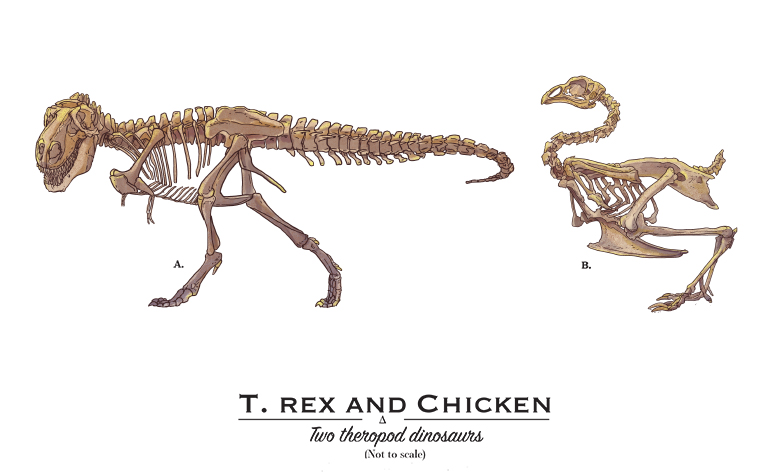
Did you notice that a lot of the bones are in the same place? What about the tails? Maybe you observed that the T. rex has a much longer tail.
Wait, birds are dinosaurs?
 The birds you see today evolved from dinosaurs that roamed earth between 145 and 201.3 million years ago. Those dinosaurs were members of a group called theropods, which included T. rex and the Velociraptor.
The birds you see today evolved from dinosaurs that roamed earth between 145 and 201.3 million years ago. Those dinosaurs were members of a group called theropods, which included T. rex and the Velociraptor.
Studying modern birds can give us insights into how those dinosaurs might have lived. For example, paleontologists can examine how modern birds incubate their eggs to hypothesize about what egg incubation might have looked like in dinosaurs.
Like birds, theropod dinosaurs were bipedal (walked on two legs), had a three-toed foot, a forcula (or wishbone), and air-filled bones. Some even had feathers!
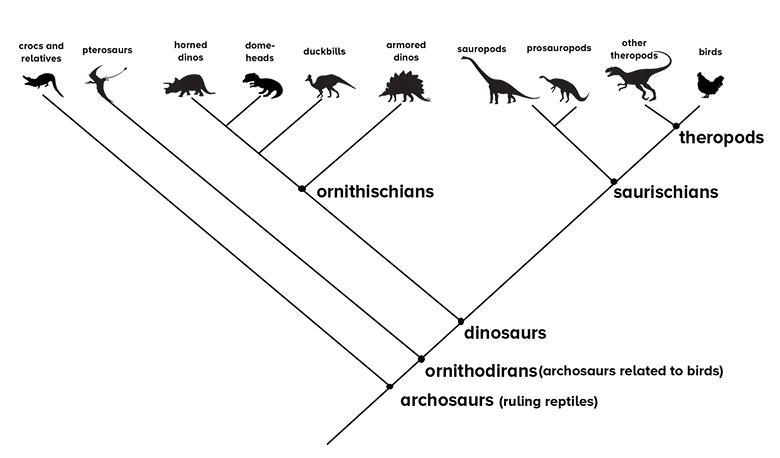
Look at the phylogenetic tree above. Phylogenetic trees like this one show the evolutionary relationships between organisms. Organisms that are close together on a phylogenetic tree have more characteristics in common than those organisms that are farther away from each other. Although many modern birds do not eat meat (e.g. hummingbirds, sparrows), the dinosaur ancestors of birds (theropod dinosaurs) were originally meat eaters.
In this activity, you will explore the evolutionary relationship between birds and theropod dinosaurs, and use a study of bird movements to create a dinosaur puppet that models how theropods might have moved.
Walking on two legs is hard

Walking on two legs is not an easy thing to do. Have you ever watched a baby learning to walk? It’s really difficult for them to keep their balance. Engineers encounter similar difficulties in designing bipedal robots like the one above. One big challenge is in mimicking the way bipedal organisms shift their weight as they walk or run.

But this makes it look easy. It is hard to picture the amount of balance and structure that allows us to move around so easily, so let’s get a closer look at the bones.
Modeling leg movement
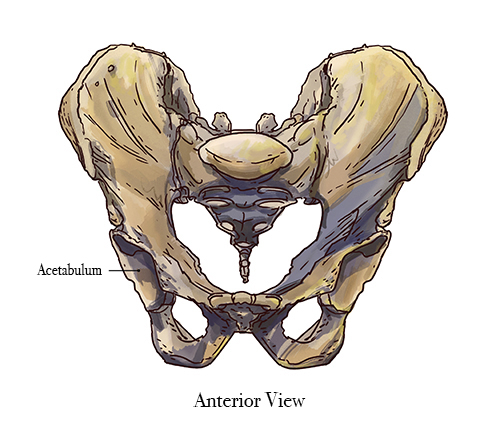
An important feature of many bipedal vertebrates is how the upper leg, called the femur, connects to a bony structure called the pelvis. This connection is called a ball-and-socket joint. In such a joint, a bone with a rounded end moves within a depression, or socket, in another bone. The pelvis has a socket—called an acetabulum—on either side, one for each leg bone. (The shoulder is another example of a ball-and-socket joint.)
Follow the directions below to model how a human leg connects to the pelvis through a ball-and-socket joint.
| Materials | |
|
|
Instructions
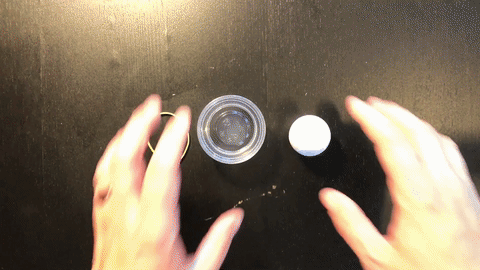
- Place the ball in the cup.
- Secure the ball in the cup with a rubber band.
- Put the toothpick in the Styrofoam ball.
- Attach the femur template to the toothpick.
- Connect the lower leg template to the femur template with a brass fastener.
- Hold on to the cup with one hand and move the leg around with your other hand.
Analysis
- Does the joint restrict the types of movement the leg can make? How so?
- Create a drawing that shows the direction of movement and the limitations of that movement.
Take a closer look at the pelvis
Now that you’ve explored how the ball-and-socket joint works, examine what pelvises look like in a human, chimpanzee, bird, and dinosaur. While looking at each pelvis, make observations and answer the following questions:
- How is each pelvis aligned with the ground? Is it perpendicular (vertical) to the ground, or is it at an angle?
- What hypotheses can you make about the way these organisms walk based on the angle of their pelvis and how their femur connects to their pelvis at the acetabulum?
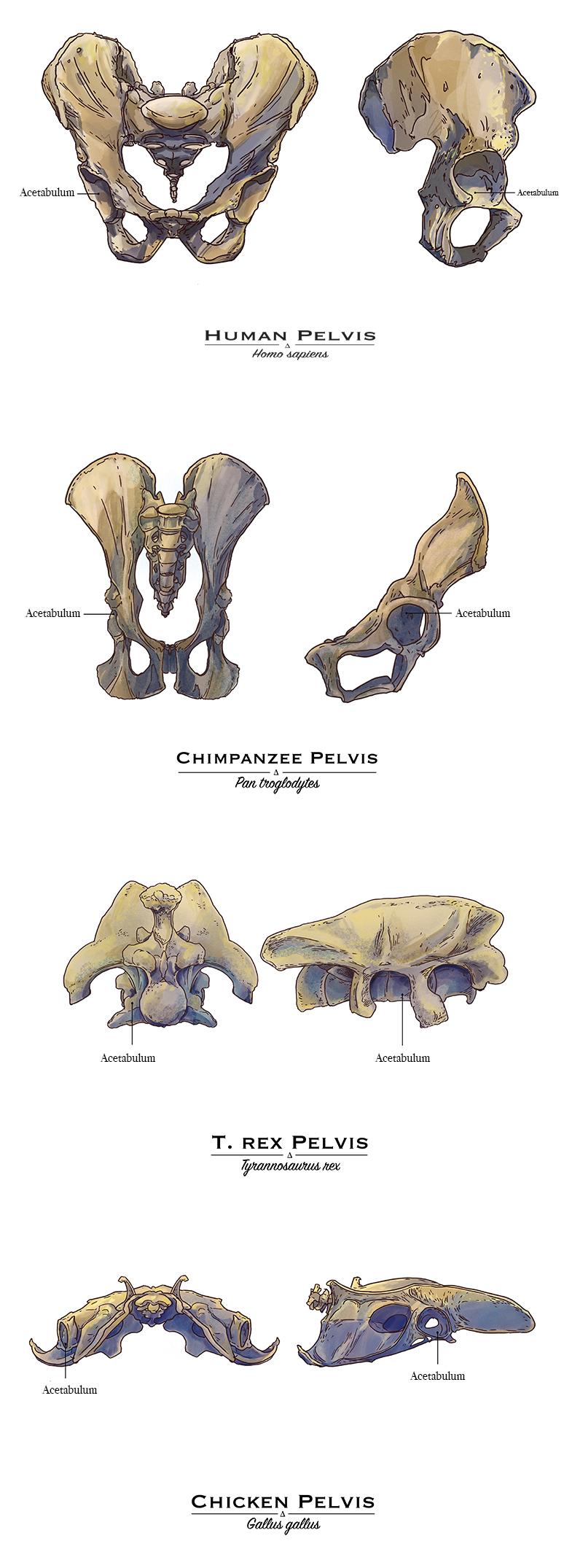
Explore hypotheses
Go back to the pelvis images and examine the shape of each acetabulum. Then use cotton to change the shape of the socket in your joint so it looks like the acetabulum of the chimpanzee. Repeat for the chicken and for the T. rex.
As you adjust the acetabulum for each species, test how the leg moves. Do different acetabulums change how far or the angles that the leg can move? Record your observations for each species on its own anchor chart. Here’s a series of blank anchor charts with images of each pelvis.
Do similarities in pelvic structure mean similar ways of walking?
How does pelvic shape relate to gait?
Gait describes the way that someone or something walks. When you walk, your heel hits the ground first. Your foot then comes down flat. Next, your heel comes off the ground as you push off with the ball, or the front part, of your foot.
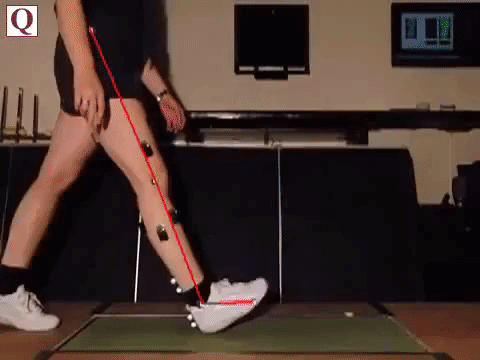
Take a look at a human’s gait
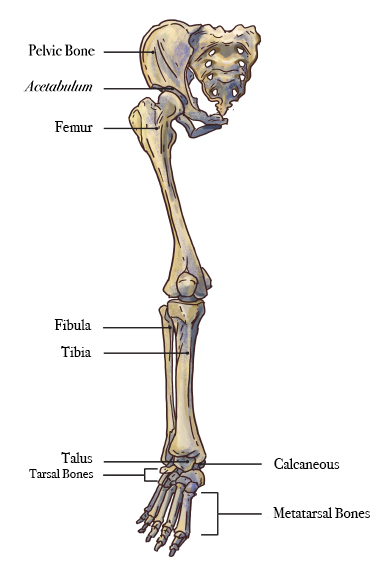
To better understand how the shape of the pelvis influences gait, let’s gather some data on the way you walk and compare it to the gait of a close relative: the chimpanzee. You can work with a partner, or set up a video camera to record yourself walking.
- Mark out a path on the floor that allows for five natural strides. (If you take one step, the distance from the back heel of one foot to the front heel of the other foot is your stride.)
- You and your partner will take turns walking and observing each other’s gait. Decide which type of data you will collect that will help you analyze gait. Examples include: The angle of your heel as it hits the ground or the angle of the tibia (shin bone) and femur at the knee.
- Take turns walking and observing.
- Record your data on your Human Anchor Chart.
Tip: Since you are measuring angles, it may help to record each other walking using the Slo-Mo function on your cell phone camera. You can then measure each angle of interest by stopping the video and using a protractor.
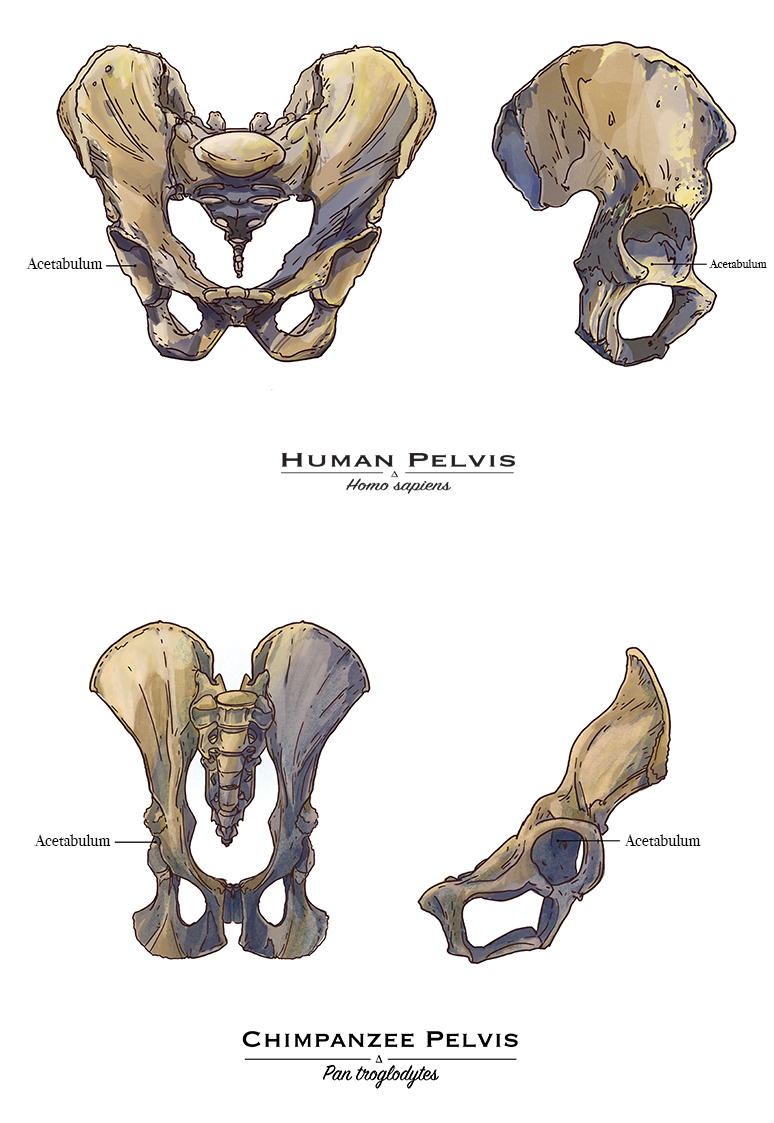
Earlier on, you created a ball-and-socket joint and adjusted it to mimic that of a chimp. Based on the shape of the chimp’s acetabulum and the positioning of its pelvis, do you think a chimp’s gait differs from a human’s? How so?
Now, take a look at a chimpanzee’s gait
- Collect the same kind of data you gathered when you observed your partner walking in the classroom.
- Record the data on your Chimpanzee Anchor Chart.
Analysis Questions
- Based on your observations, are there similarities between how the human leg moves and how the chimp leg moves?
- What were the main differences between how you and the chimp walked?
- How do you think your pelvis and the chimp’s pelvis result in the unique way that each of you moves?
- Chimpanzees don’t usually walk on two legs. Instead, they generally use their arms to help them move. Do you think that the shape of a chimpanzee’s pelvis makes it easier or harder to move on all fours? Why?
What about bird gait?
Now that we’ve investigated gait in humans and chimps, let’s take a look at gait in birds and dinosaurs. Play the first clip from the “Birds Walking” video, of the chicken walking. As you watch, look at how the chicken moves its legs. What similarities and differences do you see between the chicken’s gait and the gait of humans and chimpanzees?
- With a partner, watch the chicken clip again, followed by the rest of the “Birds Walking” video.
- Collect the same data for each of the birds that you collected when you observed your partner walking in the classroom.
- Record your data on the Bird Anchor Chart.
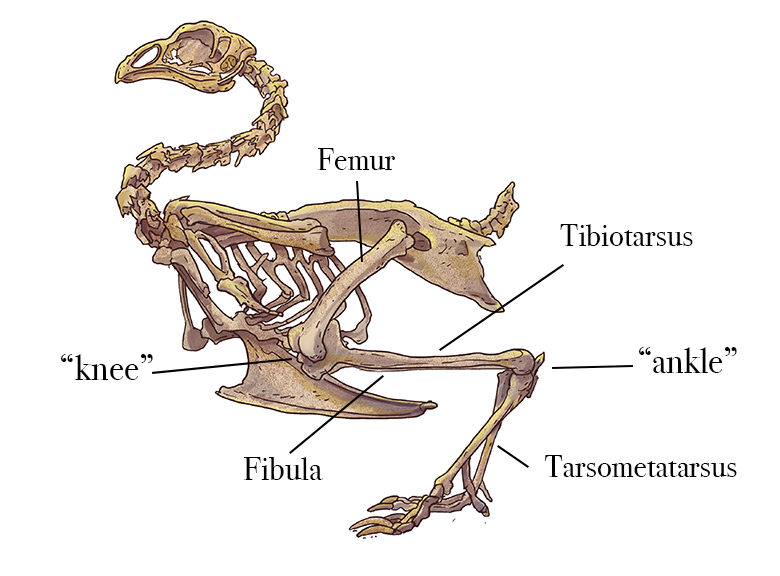
Revisit the T. rex pelvis and the chicken pelvis
What similarities do you see in their structure? What differences do you notice?
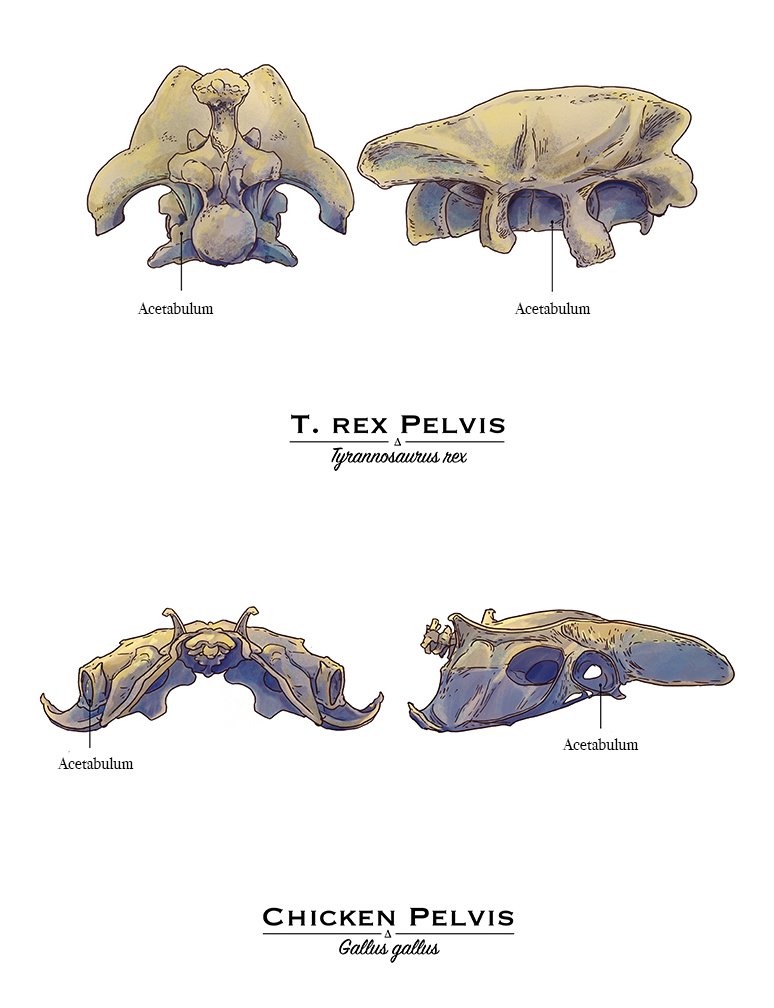
What do you think the gait of a T. rex might have been like?
Write your ideas down on your T. rex anchor chart.
Why do we care how dinosaurs moved?
Learning about dinosaur movement helps scientists understand more about how they lived, including how they hunted or foraged for food, protected themselves, mated, and raised their young.
Paleontologists, artists, and computer scientists work together to simulate the way dinosaurs moved in order to bring research to life, as well as to entertain dinosaur enthusiasts. For instance, puppeteers have combined research on dinosaur anatomy with advanced puppetry to create an awe-inspiring puppet show about dinosaurs. Watch the video below for a sneak peek.
- Did the puppets look lifelike to you? Why or why not?
- Do you think the puppeteers moved the bipedal dinosaurs in a realistic way? Why or why not?
- What scientific information was used to create the puppets?
- How did the motion of the dinosaur puppets compare to the motion of the birds in the videos you watched?
Make a puppet that moves like a theropod
In this activity, will use cardboard and other materials to construct your own dinosaur puppet, somewhat like the puppets in the video, but on a smaller scale. You will apply what you learned in earlier investigations about pelvis shape and gait to create a puppet that moves similarly to how theropods might have walked.
Your dinosaur puppet must have two fully articulated legs. For an extra challenge, make the arms, head, and jaw move.
| Suggested Materials | |
|
|
Build your dinosaur puppet.
- Decide on a theropod dinosaur that you want to make into a puppet. You can find a lot of information about T. rex online, but feel free to choose a different species that interests you. This page contains information about theropods and is a good place to start to see how the different species are related to another. Be sure to look at the Coelurosauria subgroup of theropods, which includes T. rex. and modern birds.
- Do some background research on the dinosaur you chose. Determine how long various parts of its body were, including the tail, torso, head, leg, and arm. Convert those lengths to the scale length of the model (1/2 inch = 1 foot), and write those lengths in the table on the Building a Dinosaur to Scale Worksheet.
- Sketch out a few puppet designs. Use your anchor chart notes to help guide you, and apply what you learned from earlier investigations about pelvic structure and gait.
Design considerations
—Imagine the bones in a skeleton of your dinosaur. From your research, how are they connected?
—How do you think those connections affected the way that your dinosaur moved?
—What parts of your puppet should move? What parts should be stationary?
—What kind of gait should your dinosaur have?
- Decide how you will create your puppet, based on the gait you think it should have. Here are some useful guides: 1) Shadow Puppet (using dowels) (2) Marionette (using string).
- Draw a blueprint based on your best design on your Theropod Puppet Blueprint.
— Label the location of the ball-and-socket joints and points of articulation (that is, the parts of the puppet that will move).
— Indicate what types of materials you will use to build your puppet. You will probably want to use cardboard for the majority of the design because it’s sturdy, but do you want to include construction paper.
- Write a short description of how your puppet should move on your Theropod Puppet Blueprint. For example, will it have long strides or short strides?
- Collect materials and construct your puppet.
- Test the puppet to see if it moves the way you intended, and make modifications if necessary. Write down any modifications on your blueprint.
What did dinosaurs look like?
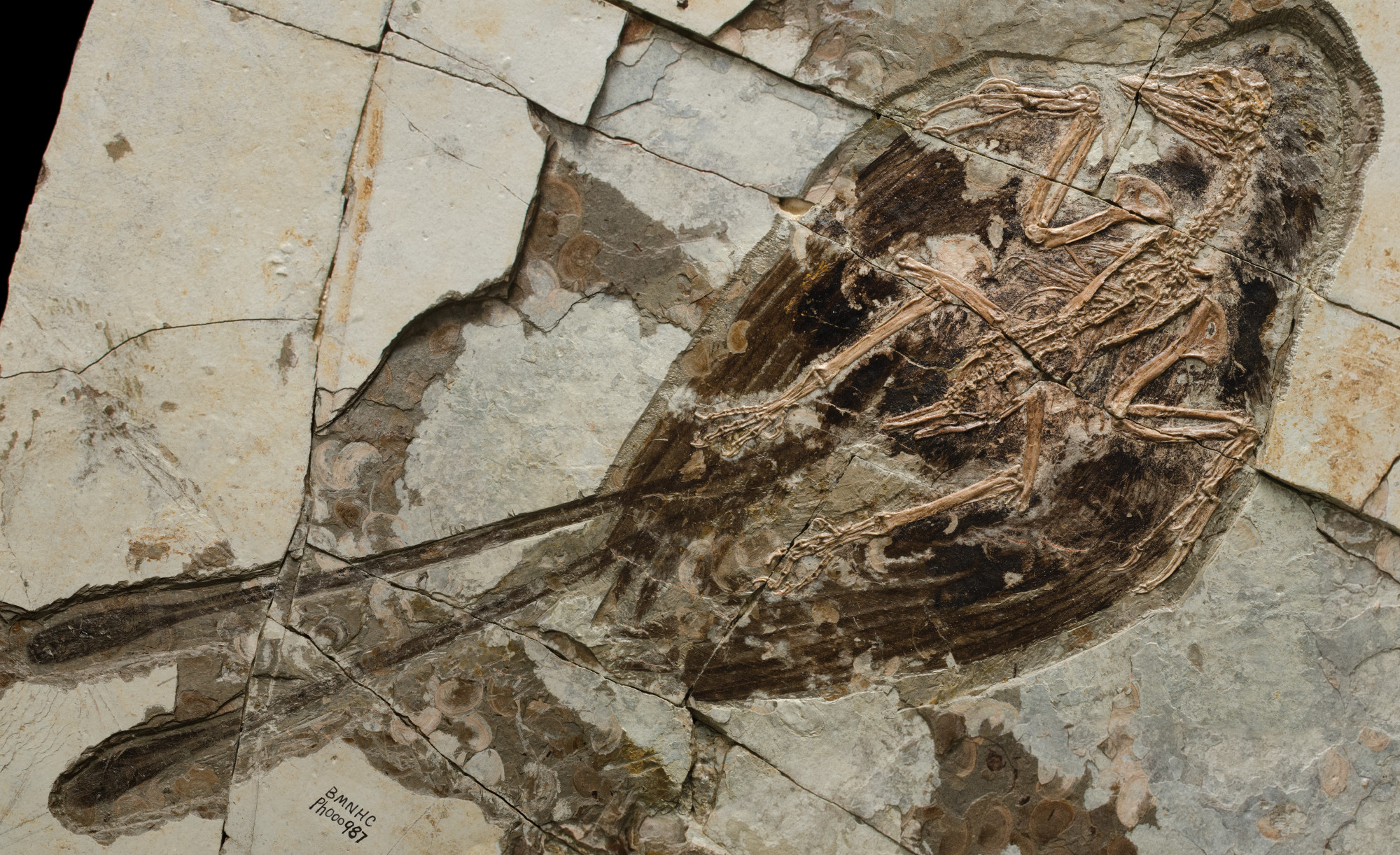
“I think that, for most people, when they hear the word ‘dinosaur,’ they see a T-rex, a Triceratops. They don’t realize that there are many dinosaurs that have been found in the fossil record that are very bird-like, that would have been the size of a chicken or something like that, with feathers, some of them even with beaks, and without teeth.”
—Luis Chiappe, Paleontologist
Read “From China, a Flock of Fossils” or “Dino Find Ruffles Feathers,” and discuss with your partner what you think the dinosaur species that you turned into puppets looked like (scales, feathers, both), and what color(s) they would have been.
After reading the article, answer the following questions:
- How do modern birds use their feathers?
- Are modern birds all the same color? Why do different types of birds have different colors?
- Many theropod dinosaurs were too big to fly. What other reasons might they have had feathers?
- What color do you think the skin of the dinosaur species you selected was? What color were its feathers?
Based on information from the article and your observations of birds, add color and detail to your puppet. You can use paint, markers, and feathers to give your dinosaur the features you think it had.
Skin doesn’t fossilize like bone, so to better understand what dinosaurs might have looked like, paleontologists rely on imprints of dinosaur bodies in mud that eventually fossilized. These sorts of remains are called trace fossils.
Whether T. rex had feathers is the subject of some debate. You might have read that some paleontologists think that T. rex didn’t have feathers at all. They came to this conclusion after looking at trace fossils of T. rex scales. These samples were a few centimeters long, and came from the neck, tail, stomach, and hip of the dinosaur.
But maybe T. rex did have feathers, just not in those locations. Or maybe T. rex babies were born with feathers and lost them as they aged. What do you think?
Videotape your puppet's gait
Once you’re done building and embellishing your theropod puppet, create a video showing your puppet moving. Use a phone, tablet, or webcam to create your film.
- Option 1: Videotape the puppet as it moves in front of a green screen, and later edit in a Mesozoic background.

Credit: Michael Kosko - Option 2: Lay the puppet flat on a printout of a Mesozoic background, and use stop motion animation to film it as if it were moving.
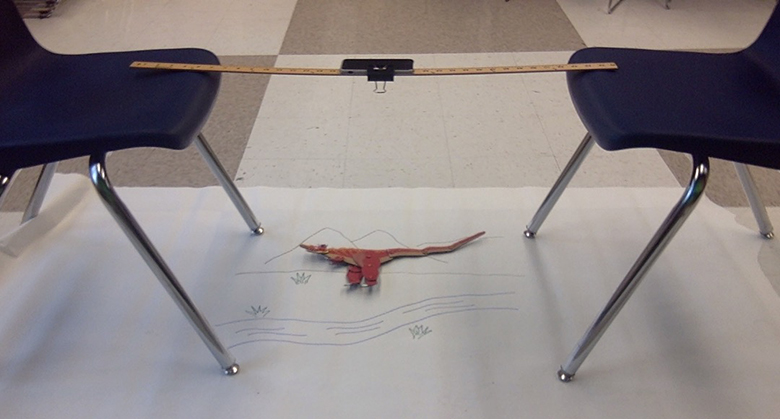
After finishing taping and editing, record your voice over the video explaining your various design decisions, such as the way the puppet’s legs move and the color of its skin. Be sure to discuss how your earlier observations of pelvises and gait in different organisms influenced your design.
Reflecting on your designs
Take turns watching other theropod puppet videos.
- Since your puppet is a simplified version of what dinosaurs actually looked like, what are its limitations? What details and functions does it show, and what is missing? How accurate is it?
- How did the earlier investigations into pelvic structure and gait help you decide how to make your puppet move?
- How can you improve your puppet based on what you saw in your classmates’ videos?
What about tails?
You might have noticed from the bird video and your dinosaur research that chickens have much smaller tails compared to the theropod dinosaurs. Long tails affected the way that the dinosaurs moved because they added more weight to their bodies: If the dinosaurs leaned too far forward, they could have tipped. If they leaned too far back, they also could have lost their balance. The video below shows how a chicken would walk if it had a long tail like a T. rex.
Putting a longer tail on a chicken changes the bird’s center of gravity, causing it to walk differently.
- How does the chicken move with the fake tail compared to without it?
- Based on what you saw in this video, would you change the way your puppet moves? Why or why not?
Original Paper: Grossi, Bruno, et al. “Walking Like Dinosaurs: Chickens with Artificial Tails Provide Clues about Non-Avian Theropod Locomotion.” PLOS ONE, Public Library of Science, 5 Feb. 2014.
Illustrations for this resource by Jay Rasgorshek.
NGSS Standards
- MS-LS4-1 – Analyze and interpret data for patterns in the fossil record that document the existence, diversity, extinction, and change of life forms throughout the history of life on Earth under the assumption that natural laws operate today as in the past.
- MS-LS4-2 – Apply scientific ideas to construct an explanation for the anatomical similarities and differences among modern organisms and between modern and fossil organisms to infer evolutionary relationships.
- LS4- A: Evidence of Common Ancestry and Diversity
- Science and Engineering Practices: Developing and using models; Planning and carrying out investigations; Engaging in argument from evidence; Obtaining, evaluating, and communication information
- Crosscutting Concepts – Patterns; Scale, proportion, and quantity; Structure and function
Note: To make this lesson more appropriate for high school students, consider incorporating the genetics of birds, crocodiles, and dinosaurs with these articles:
Have questions, comments, or feedback about this resource? E-mail us at educate@sciencefriday.com
Educator's Toolbox
Meet the Writer
About Michael Kosko
@MrKoskoMichael Kosko is the STEM initiatives manager for Chicago Public Schools. He’s a vocal advocate for technology integration and using design thinking in the classroom. By encouraging students’ interest in STEM, Michael hopes to expose them to a range of educational and career opportunities.
